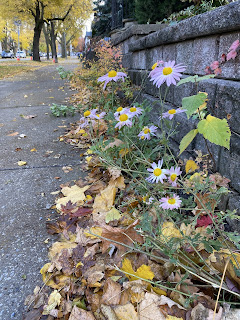I didn’t do too much this week and didn’t think that I would have enough photos to post this week but in the end, a couple of walks to new locations and I seem to have a few more photos than I anticipated.
It definitely is November! Lots of grey and cloudy days! Thankfully the temperatures are still above freezing so all precipitation is falling as rain but that’s not the same situation in other parts of the province. Every day there are fewer and fewer leaves on the trees but I continue to look for those little bursts of colour when I’m out and about.
“Think, Grow, Inquire, Create”










“Graffiti Alley” is home to a massive swath of vibrant street art - and I can’t believe that I haven’t been down here yet during these pandemic posts. Street art hasn’t always been accepted in Toronto - similarly to other big cities, the issues come down to street art versus vandalism. The debate still exists, but the current view is predominantly one of more open acceptance of street art having the power to beautify a neighbourhood. StreetARToronto (StART) is an initiative started by the City of Toronto in 2012 as a way to reduce graffiti vandalism, replacing it with creative murals and street art that engage the community and make a positive impact on the city, much like Graffiti Alley has done. This narrow stretch runs for three or four blocks, and every nook and cranny is covered in street art. Think of Graffiti Alley as an open-air gallery of living museum that encapsulates the vibrancy and diversity of Toronto. Artists regularly paint over old works and replace them with new creations, so every time you visit you’ll see something new. Here is just a small sampling:

















This building, in downtown Toronto, is the headquarters of a television/radio broadcasting hub. The building’s east wall is decorated with an actual older style news truck seemingly bursting out of the building; the front tires of the truck can be seen spinning. “Breaking News”!
Back in Week 75 my blog post talked about Guild Park and Gardens - and today I stumbled upon a small exhibit called “Lost and Found” on the grounds of an historical building. As in Guild Park, these are more architectural stone fragments from iconic Toronto buildings, salvaged when the buildings were demolished in the 1960s and 1970s.
This pediment was above the front door of Oxford University Press’s Canadian office (1929).
Ironically, the tall panel from the Granite Club (1926), and athletic and social club, is made from limestone, whereas the shorter Toronto Star building (1929) panel is made from granite.
This stone-turned bench is from the Imperial Oil building (1916).
This head of Bacchus, Roman god of wine, was in a building arch in the Ontario Bank (1868).
Corinthian capital from the Toronto Star building (1929).
Campbell House - built in 1822. Sir William Campbell (1758-1834), moved to Upper Canada (Ontario) in 1811 where he accepted a judgeship on the Court of King’s Bench. He was made Chief Justice of the province and speaker of the Legislative Council in 1825. Four years later he received the first knighthood awarded a judge in Upper Canada.
The Taylor Massey Creek takes its name from the two families that owned the land the creek flows through. Along part of the creek there is a walking trail, and this is where I found myself today.
Some amazing, old trees along the trail.
Despite walking along a creek and being in a ravine system, the reality of being in a large, urban centre pops up along the way too.
At various places along the trail you can see where, over the years, the creek changed course and washed out the pathway, and the trail has now been relocated.
Where Taylor Massey Creek and the East Don River meet.
I can’t tell you how many times I have driven along this highway and had no idea this creek and walking trail was underneath!









































































































